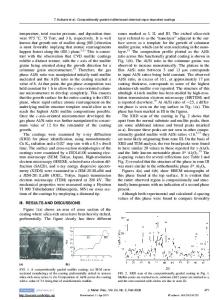Phase Transformations in Multilayered CVD Mullite Coatings
- PDF / 2,996,331 Bytes
- 6 Pages / 414.72 x 648 pts Page_size
- 53 Downloads / 368 Views
(Si[OC2H 5 14)
•--
SiO2
+
2CO)
+
2CH4
+ 2C2H 4 +
2H12
Alumina was formed from AICl 3 by a hydrolysis reaction. A1Cl 3 was formed in-situ by flowing Cl 2 with H2 as a carrier gas through aluminum chips maintained at a constant temperature. H2 and CO 2 were used to obtain the water-gas-shift reaction and form H 2 0 in-situ in the CVD reactor. The reaction was carried out at 950°C and 75 tor" pressure. The resulting alumina coatings had a corundum(a) structure. The chemical reactions are as follows:
95 Mat. Res. Soc. Symp. Proc. Vol. 3630©1995 Materials Research Society
Source:
2AI + 30
Water-gas-shift:
CO2 + H2
Deposition:
2AIC13 + 3H20
•
-)
2AIC13
---
4
H 2 0 + CO
2
-
-4
A1203 + 6HCl
The multilayered coatings were then annealed at different temperatures to facilitate the formation of mullite via interfacial reactions. RESULTS AND DISCUSSION Figure 1is a TEM micrograph of an A1203-SiO2 interface after a 2 hour anneal at 12000C, showing the presence of a 50 nm reaction zone. Chemical analysis of this reaction layer in the STEM using a 1 nxn electron probe showed the formation of a compound in which the A1203/SiO2 ratio was measured to be 65:35 (see EDS spectra in figure 1)which is close to the theoretical ratio in stoichiometric mullite. This coating exhibited no visible signs of cracking on cooling.
0
Al 0~ Si GKN
0Al
-
Fig. I TEM micrographofA120 3 -SiO2 interface after a 2 hour anneal at 12000C.
In order to widen the diffusion zone, the temperature of the post deposition anneal was increased to 13500C. This treatment resulted in the delamination of the A120 3 layer. Figure 2 is a TEM micrograph of this sample in cross section showing that the amorphous SiO 2 immediately next to the A120 3 layer had transformed into crystalline silica, as evidenced by the insert diffraction pattern. Cracks were observed at the crystalline SIO2/A1203 interface indicating that the phase transformation may be responsible for coating delamination. These results have led us to anticipate that the transformation of amorphous SiO 2 may play a key role in the poor adhesion exhibited by the coatings on Si based substrates. It is therefore felt that for any coating configuration to maintain adherence at elevated temperatures on Si based substrates, it is essential that this transformation in silica be addressed. Typically, silica layers in coatings are subjected to CTE mismatch and growth stresses. We have studied the effect of stresses and temperature on the vitreous to crystalline transformation in silica.
96
Fig. 2 TEM micrographof the multilayered coating annealed at 1350"Cfor 2hr.
To quantify the dependence of temperature and pressure on devitrification of silica, experiments were conducted on bulk silica powders. Silica has been reported to crystallize above 1347"C. 4 Amorphous silica powders were hot pressed in a graphite die using a graphite furnace with continuous flow of Ar gas at 0.01 torr chamber pressure. Powders were pressed at 1270'C, 1315*C and 1370"C with pressures of 0, 1000, 3000 and 500
Data Loading...











